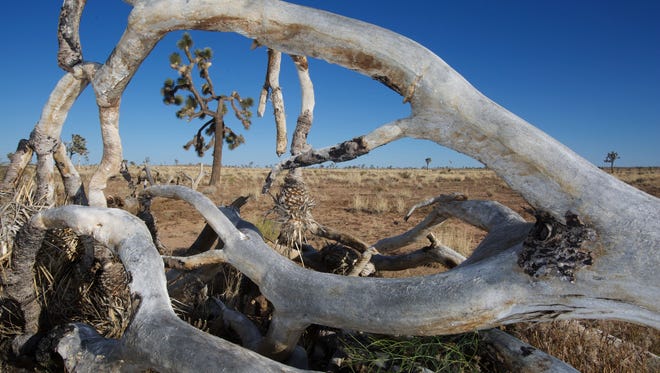Joshua trees could be declared a threatened species over climate change

PALM SPRINGS, Calif. — Joshua trees could soon follow polar bears as one of the first species to be listed as threatened due to climate change.
Federal officials announced Tuesday that they will study whether to declare the iconic trees a threatened species. The U.S. Fish and Wildlife Service reviewed a petition by the environmental group WildEarth Guardians and found it presented “substantial information” that listing Joshua trees under the Endangered Species Act may be warranted.
“This is a great step forward,” said Taylor Jones, an endangered species advocate with the WildEarth Guardians, which petitioned for federal protections for the trees in September 2015. “We’re really pleased, and it means that now the service has 12 months to look into all the available data.”
Scientists have found that Joshua trees are gradually dying out and disappearing from portions of the desert landscape in Joshua Tree National Park. As temperatures have risen, researchers say, the trees have stopped reproducing in hotter and drier low-elevation areas in the park. The knee-high young trees that normally would sprout have largely vanished in some areas, leaving mature trees that are unlikely to be replaced.
Can Endangered Species Act help Joshua trees?
Scientists have projected that by the end of this century, Joshua trees won’t be able to survive in most of the national park due to higher temperatures and will likely be able to hold on in roughly 10 percent of their current range in the park.
“We’re looking about 100 years down the road and thinking about what the Southwest is going to look like under climate change if nothing is done to halt its progress,” Jones said. “It’s very likely that we’ll have a much, much smaller and more isolated population of Joshua trees.”
The Joshua tree, Yucca brevifolia, is a type of yucca and a member of the agave family. The trees are found in areas stretching from the Mojave Desert in California to Nevada, southwestern Utah and western Arizona.
The Fish and Wildlife Service is beginning a “status review” that will involve evaluating threats to the species. The agency says the review will take at least 12 months.
For many of the plants and animals that have been declared threatened or endangered under the Endangered Species Act, the loss of habitat has been a central reason. But scientists and conservationist have increasingly focused on the role climate change is playing in pushing species toward extinction.

With sea ice melting in the Arctic, the polar bear was listed as a threatened species in 2008. The Joshua tree might become the next species — and the first plant species — to make the threatened list primarily due to climate change, depending on how quickly federal officials act.
Another species now in line for potential federal protections due to global warming is the meltwater lednian stonefly, an insect found in Glacier National Park, which the Fish and Wildlife Service has said is a candidate for listing. Conservation groups are also pressing for the wolverine to be listed, and in April a federal judge in Montana rejected a decision by the Fish and Wildlife Service to deny protections for wolverines.
Scientists say the primary threat facing Joshua trees appears to be climate change. WildEarth Guardians said in its petition that alongside climate change, “secondary and interacting threats” include drought, pollution, invasive weeds and worsening wildfires.
Cameron Barrows, an associate research ecologist at the University of California, Riverside, has studied Joshua trees and helped review the facts in the group’s 47-page petition, which summarizes scientific research on the species, before the document was submitted. But he said he isn’t taking a position on whether the trees should be listed as a threatened species.
Barrows pointed out that while government agencies have effectively protected other species by preventing habitat losses, most Joshua trees are found on public lands that aren’t likely to be developed. He said it’s very challenging for the National Park Service, the federal Bureau of Land Management or other agencies “to do anything above and beyond what they’re already doing” to protect those lands.
“Other than the education that they can provide about climate change and things like that, there’s not a lot that those land management agencies can do,” Barrows said. He added that it would clearly be positive if Joshua trees end up serving the purpose of spurring additional steps to curb emissions of greenhouse gases.
The Joshua tree was one of four species that the Fish and Wildlife Service announced it will study for listing, along with the Florida scrub lizard, Lassics lupine and Lesser Virgin Islands skink. The agency denied six other petitions, for species ranging from the American pika to the Wyoming pocket gopher.
Jones’ organization has also been pressing the federal government to stop allowing oil and gas drilling on public lands. She said she hopes to see the Joshua tree – already world famous for its fantastically crooked branches — become the first plant listed as threatened due to climate change.
“I love them. I think they look like Dr. Seuss characters, and I really hope that they stick around through the next several hundred years so that people can continue to see them,” Jones said, “and get that amazing experience of waking up at Joshua Tree National Park and seeing the silhouette of a Joshua tree against the sunrise. There’s nothing like it.”
Follow Ian James on Twitter: @TDSIanJames
